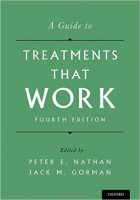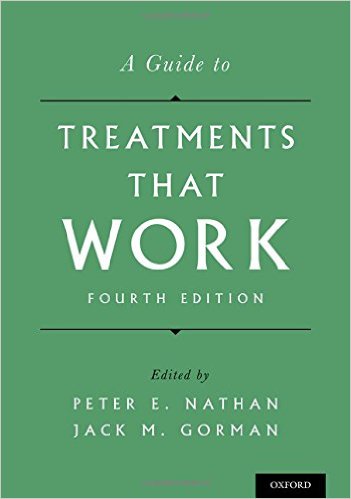 Editors: Peter E. Nathan, PhD; and Jack M. Gorman, MD
Editors: Peter E. Nathan, PhD; and Jack M. Gorman, MD
Publisher: Oxford University Press – 956 pages
Book Review by: Nano Khilnani
This book is for professionals in the field of mental health who help people that have a variety of problems, including those that affect their physical health and well-being.
In this book, you will find detailed research- and experience-based information on pharmacological and psychological treatments that work on a long list of disorders relating to human thought and action, which we name below.
Seventy-three PhDs and MDs from all over the United States who study, research, and teach a variety of behavioral and mental ailments, and treat people with them, authored or co-authored the 28 chapters of this book.
The authors were directed by the editors to rigorously evaluate the methodologies used to conduct the research on the treatments, so that the findings are not flawed. Because of this and other factors, the editors write that the treatments do work, hence the title: A Guide to Treatments That Work.
The behavioral and psychological problems the patients face or have faced were various, including: alcohol addiction, anorexia nervosa, anxiety disorders, attention-deficit disorders, attention-deficit hyperactivity disorder (ADHD), bipolar disorder, conduct disorder, eating disorders (including binge eating and bulimia), gambling disorder, impulse control disorders, disruptive behavior disorders, hyperactivity disorder; hypersomnolence disorder and narcolepsy, insomnia, major depressive disorder (MDD), neuro-cognitive disorders, obsessive-compulsive disorder, panic disorder, pediatric depression, personality disorders, phobias (including agoraphobia, the fear of leaving familiar settings), post-traumatic stress disorder (PTSD), schizophrenia, sexual dysfunction (including erectile dysfunction, premature ejaculation, and women’s sexual dysfunction after oophorectomy, or removal of the ovaries), sleep disorders, substance use disorders, trichotillomania (compulsion to pull one’s own hair), and unipolar depression.
Before laying out the chapters and their contents, the editors present in a short section in tabular form, the disorders (named “syndromes”), the treatments that work for each one, standards of proof, and references for further study. I cannot overemphasize how useful and time-saving this is for you, the busy health care professional.
So here below is an overview of what you will (and will not) find in this book, which is essentially a listing of its chapters. I urge you to read the first three chapters closely before going to the others:
- Challenges to Implementing Evidence-Based Treatments
- Evidence-Informed, Culture-Based Interventions and Best Practices in American-Indian and Alaska Native Communities
- Non-pharmacologic Treatments for Childhood Attention-Deficit/Hyperactivity Disorder and Their Combination with Medication
- Pharmacologic Treatments for Childhood Attention-Deficit/Hyperactivity Disorder and Disruptive Behavior Disorders
- Psychosocial Treatments for Conduct Disorder in Children and Adolescents
- Pharmacologic Treatments for Schizophrenia
- Cognitive and Social Cognitive Intervention for Schizophrenia
- Pharmacological Treatments for Bipolar Disorder
- Treatments for Pediatric Bipolar Disorder
- Psychological Treatments for Bipolar Disorders
- Pharmacological Treatments for Unipolar Depression
- Treatments for Pediatric Depression
- Psychosocial Treatments for Major Depressive Disorder
- Psychological Treatments for Panic, Phobias, Social and Generalized Anxiety Disorders
- Pharmacological Treatments for Panic, Generalized Anxiety & Specific Phobia Disorder
- Combined Pharmacotherapy-Psychotherapy for Major Depressive & Anxiety Disorders
- Treatments for Obsessive-Compulsive Disorder
- Psychosocial Treatments for Posttraumatic Stress Disorder
- Pharmacological Treatment of Posttraumatic Stress Disorder
- Treatments for Eating Disorders
- Treatment of Sleep Disorders
- Pharmacotherapy and Psychotherapy for Sexual Dysfunctions
- Psychosocial Treatments for Substance Use Disorders
- Psychopharmacological Treatments for Substance Use Disorders
- Treatments for Gambling Disorder and Impulsive Control Disorders
- Treatments for Neuro-cognitive Disorders
- Psychological Treatments for Personality Disorders
- Psychopharmacological Treatment of Personality Disorders
In the chapters you will find well-organized materials and detailed discussions of topics including, importantly:
- A short abstract of the contents of the chapter
- An Introduction
- Presentation and discussion of diagnostic cues to the disorder being covered in it
- Review of research published / reported in the last few years that is basically the evidence supporting the treatments
- Tables presenting data from the research studies
- Conclusion
- References for further study
This is an excellent text for all people working in mental health.
Editors:
Peter E. Nathan, PhD received his doctor’s degree in clinical psychology from Washington University in 1962. After spending two years as a research fellow, he joined the Harvard psychiatry service at Boston City Hospital. In 1969, he became a Professor of Psychology and Director of Clinical Training at Rutgers University, later serving as Henry and Anna Star Professor and Director of the Rutgers Center of Alcohol Studies. In 1990 he accepted the position of Provost and Distinguished Professor of Psychology at the University of Iowa and became Emeritus in 2007.
Jack M. Gorman, MD received his medical degree from the College of Physicians and Surgeons of Columbia University in 1977 and did residency and fellowship training in the Columbia University Department of Psychiatry / New York Psychiatric Institute program. He remained on the faculty of Columbia’s psychiatry department for the next 25 years, eventually serving as Lieber Professor of Psychiatry. He then became the Esther and Joseph Klingenstein Professor and Chair of Psychiatry and Professor of Neuroscience at the Mount Sinai School of Medicine. He currently consults to organizations working to improve behavioral health care in the United States and Canada.






